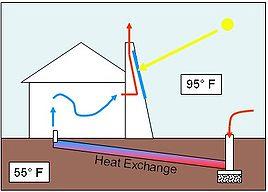In Ancient Building Principles, I discussed how the Romans and Native Americans used thermal mass and flow channels to heat and cool Roman bath houses and the Navajo Hogans.
Along with these time tested and ancient principles of nature, there was another common technique used in passively heating and cooling buildings: thermal chimneys. Thermal chimneys are also referred to as solar chimneys; and is the process of a natural convection caused by solar gain on the top portion of a structure, heating the air inside the ventilation chamber, usually a tall chimney, and naturally drawing the cooler air from the lower portion of the ventilation chamber.
This natural convection current results in pulling cool air from the ground floor, or in the case of a geothermal exchange, through the ground itself; and releasing the heated air out the top of the building. During the summer, this effectively cools the interior of the building.
 This picture shows air passively (no moving or mechanical parts) being drawn through a geothermal heat exchange, cooling the house, and exiting through the top of the thermal chimney.
This picture shows air passively (no moving or mechanical parts) being drawn through a geothermal heat exchange, cooling the house, and exiting through the top of the thermal chimney.
Thermal convection in construction has been used for centuries, dating back to Persia where windcatchers were used effectively to cool structures in the middle of the desert.
The C.O.R.E. Technology incorporates thermal convection principles into the C.O.R.E. Home design to completely heat and cool itself year round. To learn more about how the C.O.R.E. Home works, watch our video at www.TheCoreHome.com/video.
